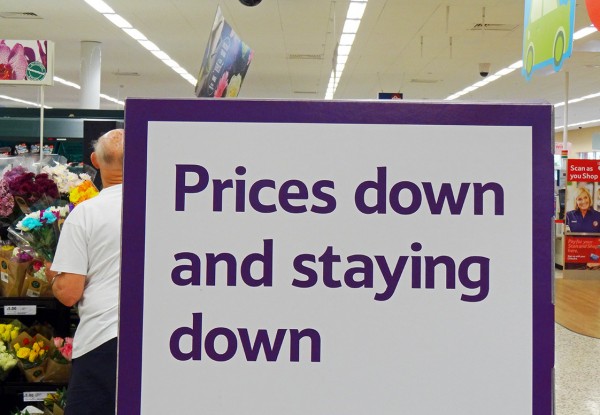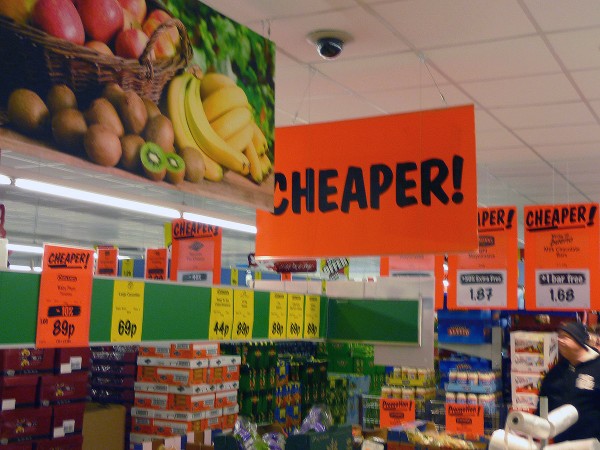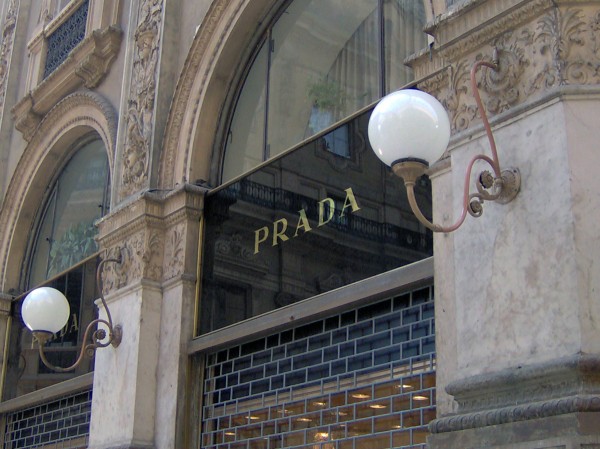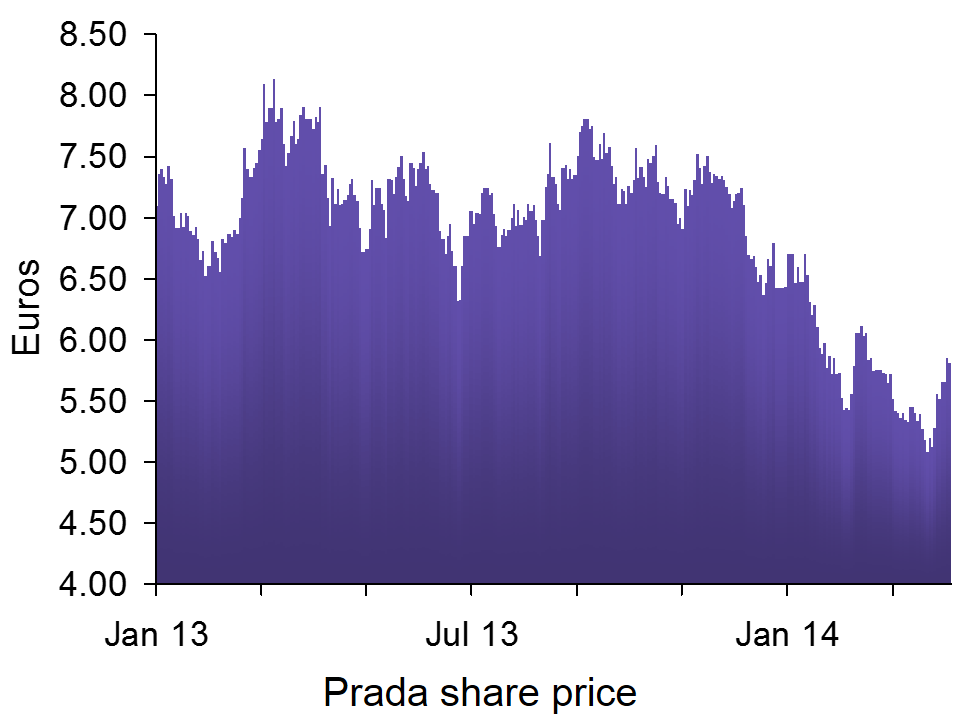 The retail food industry is an oligopoly – a market dominated by a few big firms, with interdependence between them. This means that each firm considers the reaction of all its competitors when making any decision. Pricing is one of those key decisions and this is one of the reasons why price wars tend to break out in this industry.
The retail food industry is an oligopoly – a market dominated by a few big firms, with interdependence between them. This means that each firm considers the reaction of all its competitors when making any decision. Pricing is one of those key decisions and this is one of the reasons why price wars tend to break out in this industry.
For consumers, price wars are usually seen as a good thing, as it means prices in the supermarkets get forced downwards, thus reducing the cost of living. Low prices in this case are one of the key benefits of competition. However, there are costs of such fierce competition for suppliers.  As final prices to customers are pushed down, small competitors are likely to feel the squeeze and may be forced out of the market. The other losers are suppliers. The big supermarkets are likely to pay lower prices to their suppliers, thus adversely affecting their livelihood. Research suggests that throughout 2014, 146 food producers entered insolvency, which is significantly higher than last year.
As final prices to customers are pushed down, small competitors are likely to feel the squeeze and may be forced out of the market. The other losers are suppliers. The big supermarkets are likely to pay lower prices to their suppliers, thus adversely affecting their livelihood. Research suggests that throughout 2014, 146 food producers entered insolvency, which is significantly higher than last year.
Accountancy firm, Moore Stephens, has blamed the supermarket price war for this rise in insolvencies in the food production sector. Duncan Swift from this firm said:
“The supermarkets are going through the bloodiest price war in nearly two decades and are using food producers as the cannon fodder…Supermarkets have engaged in questionable buying practices for years, but it’s getting worse and clearly wreaking havoc on the UK food production sector.”
The British Retail Consortium has said that placing the blame in this way was too simplistic. A commentator suggested that many suppliers have long-standing relationships with the supermarkets they deal with, suggesting that relations were good and sustainable. Furthermore, it was suggested that the demise of these producers may be due to many other factors and the data on insolvencies did not show that those firms affected were suppliers to the supermarkets. There is a Groceries Code Adjudicator in place to ensure that the supermarkets do not abuse their power when it comes to dealing with their suppliers, but the power of this person is limited, leaving suggestions remaining that suppliers are vulnerable. The following articles consider both the good and bad of price wars.
Furthermore, it was suggested that the demise of these producers may be due to many other factors and the data on insolvencies did not show that those firms affected were suppliers to the supermarkets. There is a Groceries Code Adjudicator in place to ensure that the supermarkets do not abuse their power when it comes to dealing with their suppliers, but the power of this person is limited, leaving suggestions remaining that suppliers are vulnerable. The following articles consider both the good and bad of price wars.
Articles
Questions
- What are the characteristics of an oligopoly? Why do price wars tend to break out in oligopolies, such as the supermarket industry?
- Apart from the supply-chain pressure from supermarkets, what other factors could have caused so many small food producers to become insolvent?
- How does the supermarket supply chain work and why have the price wars led to suppliers being squeezed?
- Use a diagram to illustrate the impact of the price war on (a) the supermarkets and (b) the suppliers.
- How important is the Groceries Code Adjudicator and should she be doing more to protect suppliers?
- If supermarkets are cutting prices, is this an indicator of unfair competition or good competition?
 The market structure in which firms operate has important implications for prices, products, suppliers and profits. In competitive markets, we expect to see low prices, many firms competing with new innovations and firm behavior that is in, or at least not against the public interest. As a firm becomes dominant in a market, its behavior is likely to change and consumers and suppliers can be adversely affected. Is this the case with Amazon?
The market structure in which firms operate has important implications for prices, products, suppliers and profits. In competitive markets, we expect to see low prices, many firms competing with new innovations and firm behavior that is in, or at least not against the public interest. As a firm becomes dominant in a market, its behavior is likely to change and consumers and suppliers can be adversely affected. Is this the case with Amazon?
Much attention has been given to the dispute centering around Amazon and its actions in the market for e-books, where it holds close to two thirds of the market share. Critics of Amazon suggest that this is just one example of Amazon using its monopoly power to exploit consumers and suppliers, including the publishers and their authors. Although Amazon is not breaking any laws, there are suggestions that its behavior is ‘brutal’ and is taking advantage of consumers, suppliers and its workforce.
But rather than criticizing the actions of a monopolist like Amazon, should we instead be praising the company and its ability to compete other firms out of the market? One of the main reasons why consumers use Amazon to buy goods is that prices are cheap. So, in this respect, perhaps Amazon is not acting against consumers’ interests, as under a monopoly we typically expect low output and high prices, relative to a model of perfect competition. The question of the methods used to keep prices so low is another matter. Two conflicting views on Amazon can be seen from Annie Lowrey and Franklin Foer, who respectively said:
“Amazon relentlessly drives down prices for goods and services and delivers them fast and cheap. It ploughs its profits into price cuts and innovation rather than putting them in the hands of its investors. That benefits millions of families – full stop.”
“In effect, we’ve been thrust back 100 years to a time when the law was not up to the task of protecting the threats to democracy posed by monopoly; a time when the new nature of the corporation demanded a significant revision of government.”
So, with Amazon we have an interesting case of a monopolist, where many aspects of its behaviour fit exactly into the mould of the traditional monopolist. But, some of the outcomes we observe indicate a more competitive market. Paul Krugman has been relatively blunt in his opinion that Amazon’s dominance is bad for America. His comments are timely, given the recognition for Jean Tirole’s work in considering the problems faced when trying to regulate any firm that has significant market power. He has been awarded the Nobel Prize in Economics. I’ll leave you to decide where you place this company on the traditional spectrum of market structures, as you read the following articles.
Amazon: Monopoly or capitalist success story? BBC News, Kierran Petersen (14/10/14)
Why the Justice Department won’t go after Amazon, even though Paul Krugman thinks it’s hurting America Business Insider, Erin Fuchs (20/10/14)
Is Amazon a monopoly? The Week, Sergio Hernandez (19/11/14)
Big, bad Amazon The Economist (20/10/14)
Questions
- What are the typical characteristics of a monopoly? To what extent does Amazon fit into this market structure?
- Why does Paul Krugman suggest that Amazon is hurting America?
- How does Amazon’s behaviour with regard to (a) its suppliers and (b) its workers affect its profitability? Would it be able to behave in this way if it were a smaller company?
- Why is Amazon able to charge its customers such low prices? Why does it do this, given its market power?
- Is there an argument for more regulation of firms with such dominance in a market, as is the case with Amazon?
- The debate over e-books is ingoing. What is the argument for publishers to be able to set a minimum price? What is the argument against this?
- Should customers boycott Amazon in a protest over the alleged working conditions of Amazon factory employees?
 One example of an oligopoly was recently discussed on this blog –supermarkets. Here, is another classic example: the energy sector. It is dominated by six big firms, which hold the majority of the market in an industry with high barriers to entry; there is inter-dependence between the firms; and there are accusations of price fixing and collusion – all typical features of an oligopoly that may operate against consumers’ interests.
One example of an oligopoly was recently discussed on this blog –supermarkets. Here, is another classic example: the energy sector. It is dominated by six big firms, which hold the majority of the market in an industry with high barriers to entry; there is inter-dependence between the firms; and there are accusations of price fixing and collusion – all typical features of an oligopoly that may operate against consumers’ interests.
There have been numerous investigations into the actions of these energy providers, owing to their high prices, a lack of competition and significant profits. Developments in the industry have focused on reducing the barriers to entry created by the vertical integration of the incumbent firms in order to make it easier for new firms to enter, thus boosting competition.
However, the latest step is the biggest one, with the energy regulator, Ofgem, referring this industry to the Competition and Markets Authority (CMA). The investigation is likely to last 18 months and will ‘leave no stone unturned in establishing the truth behind energy prices’.
One of the key things that will be investigated is the accusation of profiteering and thus whether the big six should be broken up. This would inevitably lead to reductions in entry barriers and more opportunities for new firms to enter the market, thereby creating a much needed increase in competition. The Chief Executive of Ofgem, Dermot Nolan said:
Now is the right time to refer the energy market to the CMA for the benefit of consumers…There is near-unanimous support for a referral and the CMA investigation offers an important opportunity to clear the air. This will help rebuild consumer trust and confidence in the energy market as well as provide the certainty investors have called for.
Further comments were made about the energy sector and the future direction in terms of market reforms. This was another reason given for the referral to the CMA. Dermot Nolan added:
A CMA investigation should ensure there are no barriers to stop effective competition bearing down on prices and delivering the benefits of these changes to consumers.
The impact of this latest news will undoubtedly be felt by the big six, with share prices already taking a small hit, as investors start to look ahead to the potential outcome, despite any decision not being expected for a good 18 months. The following articles consider this latest energy market development.
Ofgem puts big six energy suppliers under CMA spotlight The Guardian, Terry Macalister (26/6/14)
Ofgem refers ‘big six’ energy groups for competition probe Financial Times, Claer Barrett (26/6/14)
U.K. energy regulator Ofgem asks for utilities probe Wall Street Journal, Selina Williams (26/6/14)
Energy probe could lead to ‘major structural change’ BBC News (26/6/14)
Probe into energy firms’ £100 per home profits The Telegraph, Emily Gosden (26/6/14)
UK competition watchdog kicks off energy suppliers probe Reuters (26/6/14)
Energy sharks may £101 profit per family: Major inquiry launched into power Mail Online, Sean Poulter (26/6/14)
Big six energy firms face full competition probe Independent, Simon Read (26/6/14)
Questions
- How well does the energy sector fit the structure of an oligopoly?
- What are the barriers to entry in the energy market? How can this referral to the CMA help to reduce them?
- Which factors determine the price of energy?
- The big six have been accused of profiteering. What is meant by this and why is it against the public interest?
- Why has it taken so long for such a referral to take place?
- In the BBC News article, the suggestion is that this investigation could lead to a ‘major structural change’. What is meant by this and why is it a possibility?
 Globalisation has led to an increasingly interdependent world, with companies based in one country often dependent on a market abroad. In recent years, it is the rapid growth of countries like China that has led to growth in the size of the markets for many products. With incomes rising in emerging countries, demand for many products has been growing, but in the past year, the trend for Prada has ended and seems to be reversing.
Globalisation has led to an increasingly interdependent world, with companies based in one country often dependent on a market abroad. In recent years, it is the rapid growth of countries like China that has led to growth in the size of the markets for many products. With incomes rising in emerging countries, demand for many products has been growing, but in the past year, the trend for Prada has ended and seems to be reversing.
As the market in China matures and growth of demand in Europe slows, Prada has seen its shares fall by the largest margin since June last year.
Prada is a well-known luxury brand. The products it sells are relatively expensive and hence its products are likely to have an income elasticity of demand well above +1. With changes in China and Europe, Prada expects its growth in sales to January 2015 will be ‘low single-digit’ – less than the 7% figure recorded for the last financial year.
 This lower growth in same-store sales is likely to continue the following year as well. Add on to this the lower-than-expected profits, which missed analysts’ forecasts, and you have a prime example of a brand that is suffering because of its customer base and the economic times.
This lower growth in same-store sales is likely to continue the following year as well. Add on to this the lower-than-expected profits, which missed analysts’ forecasts, and you have a prime example of a brand that is suffering because of its customer base and the economic times.
Prada isn’t alone in suffering from economic conditions and, relative to its European counterparts, is expected to have higher growth in sales and profits in the next 12 months – at 11.5% and 14.8% respectively. This is according to a survey by Thomson Reuters.
 Prada has exploited high demand by Chinese consumers, but has recently been affected by the strength of the euro. A strong euro means that the Italian-based Prada is struggling with exports, which only adds to its problems. As economic growth picks up in China and as other emerging economies begin to experience more rapid economic growth, the fortunes of this luxury-retailer may change once more. However, with volatile economic times still around in many countries, the future of many retailers selling high-end products to higher income customers will remain uncertain. The following articles consider the fortunes of Prada.
Prada has exploited high demand by Chinese consumers, but has recently been affected by the strength of the euro. A strong euro means that the Italian-based Prada is struggling with exports, which only adds to its problems. As economic growth picks up in China and as other emerging economies begin to experience more rapid economic growth, the fortunes of this luxury-retailer may change once more. However, with volatile economic times still around in many countries, the future of many retailers selling high-end products to higher income customers will remain uncertain. The following articles consider the fortunes of Prada.
Prada shares fall sharply after China luxury warning BBC News (3/4/14)
Prada falls after forecasting slowing luxury sales growth Bloomberg, Andrew Roberts and Vinicy Chan (3/4/14)
Prada profits squeezed by weakness in Europe and crackdown in China The Guardian (2/4/14)
Prada bets on men to accelerate sales growth Reuters, Isla Binnie (2/4/14)
Prada misses full year profit forecast Independent, Laura Chesters (2/4/14)
Questions
- How can we define a luxury product?
- Explain the main factors which have led to a decline in the demand for Prada products over the past 12 months.
- Using a diagram, illustrate what is meant by a strong euro and how this affects export demand.
- What business strategies are Prada expected to adopt to reverse their fortunes?
- Using a diagram, explain the factors that have caused Prada share prices to decline.
 The supermarket industry is a classic example of an oligopoly. A market dominated by a few large companies, which is highly competitive and requires the companies to think about the reactions of the other competitors whenever a decision is made. Throughout the credit crunch, price cutting was the order of the day, as the big four tried to maintain market share and not lose customers to the low cost Aldi and Lidl. Morrisons, however, has found itself in exactly that position and is now looking to restructure to return to profitability.
The supermarket industry is a classic example of an oligopoly. A market dominated by a few large companies, which is highly competitive and requires the companies to think about the reactions of the other competitors whenever a decision is made. Throughout the credit crunch, price cutting was the order of the day, as the big four tried to maintain market share and not lose customers to the low cost Aldi and Lidl. Morrisons, however, has found itself in exactly that position and is now looking to restructure to return to profitability.
Morrisons is well known for its fresh food, but it seems that with incomes still being squeezed, even this is insufficient to keep its customers from looking for cheaper alternatives. Morrisons’ market share has been in decline and its profits or the last financial year have been non-existent. It’s been losing ground to its big competitor, Tesco and part of this is due to the fact that Morrisons was late to enter the ‘Tesco metro’ market. It remained dependent on its large supermarkets, whereas Tesco saw the opportunity to expand onto the highstreets, with smaller stores. It was also late arriving to the online shopping business and while it has now developed more sophisticated IT systems, it did lose significant ground to Tesco and its other key competitors.

Another problem is that Morrisons has found itself unable to compete with the low cost supermarkets. The prices on offer at Morrisons are certainly not low enough to compete with prices at Aldi and Lidl and Morrisons has seen many of its customers switch to these cheaper alternatives. But Morrisons is fighting back and has announced plans to cut prices on a huge range of products across its stores. The fresh food aspect of the business will still remain and the hope is that the fresh food combined with cheaper price tags will allow Morrisons to re-gain lost ground to Tesco and take back some of its lost customers from the low-cost alternatives. However, it’s not just Morrisons that has been losing customers to the budget retailers. Tesco, Sainsbury’s and Asda have all lost market share to Aldi and Lidl, but it is Morrisons that has fared the worst.
The latest news on Morrisons’ profits and overall performance, together with its promise of restructuring and price cuts worth £1 billion has caused uncertainty for shareholders and this has reduced the value of shares. However, Morrisons’ Directors have tried to restore confidence by purchasing shares themselves. With expectations of price wars breaking out, the other supermarkets have also seen significant declines in their share values, with a total of £2 billion being wiped off the value of their shares collectively. The consequences of Morrisons’ performance will certainly continue: customers are likely to benefit from lower prices in all of the big four supermarkets, but investors may lose out – at least in the short run. The impact on jobs is uncertain and will certainly depend on how investors and customers react in the coming weeks. The following articles consider this sector.
UK grocer Morrison warns on profit, threatens price war Reuters, James Davey (13/3/14)
Morrisons and the threat to mainstream supermarkets BBC News, Robert Peston (13/3/14)
Morrisons expected to sell property in response to profit drop The Guardian (9/3/14)
Morrisons restructuring sparks fears of new price war BBC News (13/3/14)
Morrisons’ dividend up while profit falls? It’s hard to believe The Guardian, Nils Pratley (13/3/14)
Morrisons boss talks tough as group slides into red The Scotsman, Scott Reid (13/3/14)
Morrisons plots price cuts after annual loss Sky News (13/3/14)
Morrisons’ declaration of £1bn price war with budget stores hammers Sainsbury and Tesco shares This is Money, Rupert Steiner (14/3/14)
Ocado on track for first profit in wake of Morrisons deal Independent, Simon Neville (14/4/14)
Questions
- What are the key characteristics of an oligopoly?
- To what extent do you think the supermarket sector is a good example of an oligopoly?
- Why is the characteristic of interdependence a key cause of the potential price war between the supermarkets?
- Why has Morrisons been affected so badly with the emergence of the budget retailers?
- By using the income an substitution effect, explain how the big four supermarkets have been affected by retailers, such as Aldi and Lidl.
- Using a demand and supply diagram, explain how the share prices of companies like Morrisons are determined. Which factors affect (a) the demand for and (b) the supply of shares?
- What do you think will happen to the number of jobs in Morrisons given the performance of the company and its future plans?
 The retail food industry is an oligopoly – a market dominated by a few big firms, with interdependence between them. This means that each firm considers the reaction of all its competitors when making any decision. Pricing is one of those key decisions and this is one of the reasons why price wars tend to break out in this industry.
The retail food industry is an oligopoly – a market dominated by a few big firms, with interdependence between them. This means that each firm considers the reaction of all its competitors when making any decision. Pricing is one of those key decisions and this is one of the reasons why price wars tend to break out in this industry. As final prices to customers are pushed down, small competitors are likely to feel the squeeze and may be forced out of the market. The other losers are suppliers. The big supermarkets are likely to pay lower prices to their suppliers, thus adversely affecting their livelihood. Research suggests that throughout 2014, 146 food producers entered insolvency, which is significantly higher than last year.
As final prices to customers are pushed down, small competitors are likely to feel the squeeze and may be forced out of the market. The other losers are suppliers. The big supermarkets are likely to pay lower prices to their suppliers, thus adversely affecting their livelihood. Research suggests that throughout 2014, 146 food producers entered insolvency, which is significantly higher than last year. Furthermore, it was suggested that the demise of these producers may be due to many other factors and the data on insolvencies did not show that those firms affected were suppliers to the supermarkets. There is a Groceries Code Adjudicator in place to ensure that the supermarkets do not abuse their power when it comes to dealing with their suppliers, but the power of this person is limited, leaving suggestions remaining that suppliers are vulnerable. The following articles consider both the good and bad of price wars.
Furthermore, it was suggested that the demise of these producers may be due to many other factors and the data on insolvencies did not show that those firms affected were suppliers to the supermarkets. There is a Groceries Code Adjudicator in place to ensure that the supermarkets do not abuse their power when it comes to dealing with their suppliers, but the power of this person is limited, leaving suggestions remaining that suppliers are vulnerable. The following articles consider both the good and bad of price wars.





